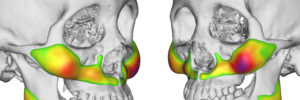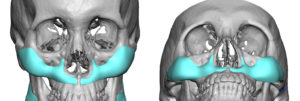Cheek implants provide augmentation to the cheekbone or zygomatic major bony prominence. This produces an anterolateral midface effect that is useful for more common augmentations of isolated and mild to moderate aesthetic cheek deficiencies.
But the cheekbone is part of the overall midface skeleton with extensions onto the eye (infraorbital rim) and the upper jaw. (maxilla) As a result, when midface developmental deficiencies occur or in certain ethnicities the facial effects are more than just a lack of adequate cheek projection. The entire midface can be deficient as manifest with a flatter face appearance that lacks overall horizontal projection.

This custom cheek-maxillary-paranasal implant is placed through an incision inside the mouth like standard cheek implants are. It is easier to position than standard cheek implants due to its length and visible positioning up against the pyriform aperture. The risk of malposition is low as most of the implant is visible inside the mouth during placement.
Dr. Barry Eppley
Indianapolis, Indiana



